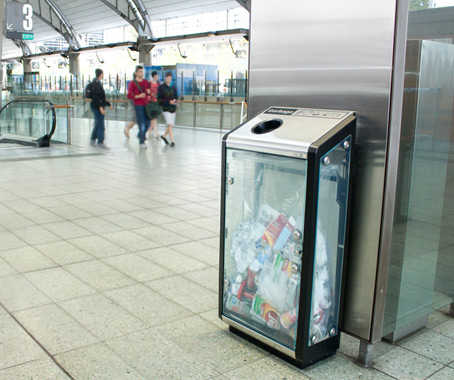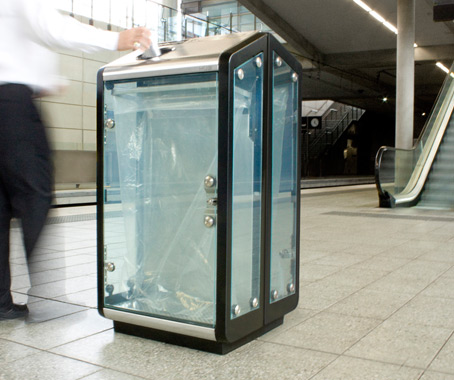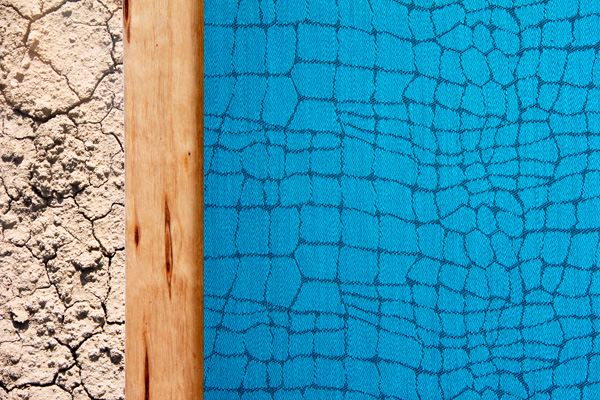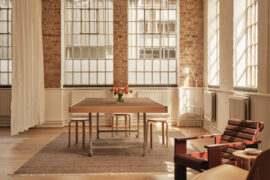The HUB.20/20 Bin accomodates safety, functionality and aesthetics.
November 10th, 2010
Rubbish bins hardly rate highly on the list of most-coveted design objects.
In fact they tend to go unappreciated, until you need one – and then you can’t help but notice a lack of them.
Because of heightened security concerns, this has been the case in Sydney train stations for ten years now – much to the dismay of commuters (and cleaning staff no doubt).
But after a gruelling process to find the right designers for the job, RailCorp has arrived at a solution: the HUB.20/20 Bin.
The design team from HUB Street Equipment collaborated with RailCorp and the University of Technology, Sydney to create a receptacle that would satisfy the broad scope of stakeholder expectation.
“The biggest challenge was ensuring all stakeholders’ needs were addressed without compromising others,” says HUB’s General Manager Anton Beardmore.
“The design brief was developed by RailCorp and included feedback from all relevant stakeholders including the NSW Police Force, maintenance staff, access specialists, security staff, station management, presentation staff, OH&S, RailCorp Management and RailCorp Procurement.”
The HUB.20/20 Bin is the end product, reconciling issues of robustness, ease and efficiency of installation, operation, cleaning and maintenance, safety, vandal resistance, disabled access and visual access.
Take one look at the bin and it’s obvious aesthetics weren’t compromised either.
“In addition to satisfying all these ‘needs’ which can often pull design in opposite directions, HUB continually strives to ensure the final design is beautiful,” says Beardmore.
The bin, made from stainless steel, clear polycarbonate and cast aluminium is simple but elegant, thanks to the design being pared down to meet the need for functionality and safety.
HUB Street Equipment
hubstreetequipment.com.au


INDESIGN is on instagram
Follow @indesignlive
A searchable and comprehensive guide for specifying leading products and their suppliers
Keep up to date with the latest and greatest from our industry BFF's!

How can design empower the individual in a workplace transforming from a place to an activity? Here, Design Director Joel Sampson reveals how prioritising human needs – including agency, privacy, pause and connection – and leveraging responsive spatial solutions like the Herman Miller Bay Work Pod is key to crafting engaging and radically inclusive hybrid environments.
The new range features slabs with warm, earthy palettes that lend a sense of organic luxury to every space.

Gaggenau’s understated appliance fuses a carefully calibrated aesthetic of deliberate subtraction with an intuitive dynamism of culinary fluidity, unveiling a delightfully unrestricted spectrum of high-performing creativity.

In celebrating the launch of their new Sydney store recently, we speak with global luxury watch retailers, The Hour Glass, on what drives their retail philosophy and the value of authenticity in their environments.
Sydney’s design community crowded around to hear about Wilkhahn’s latest launch – the revolutionary new task chair ‘ON’ which is the first chair to have three-dimensional support with swivel points left to right as well back to front to make a truly ergonomic seating experience.

Kicking off our new series on the design enthusiasts who work in all sorts of different roles across the industry, we get to know Spence & Lyda’s Ana Cuellar.

The collaboration between global textile supplier Camira, and At Work* in New Zealand, is already a big success in Australasia. A key factor in this has been both brands’ shared vision and enduring passion to provide innovative, quality and sustainable commercial textiles, along with strong service and team efforts.
The internet never sleeps! Here's the stuff you might have missed

Featuring beloved Melbourne designers, this is a must-attend conversation for emerging designers and anyone interested in the pursuit of creativity.

THISS Studio has completed the interior fit out of a flexible office and creative space in east London for independent communications studio, SALT.